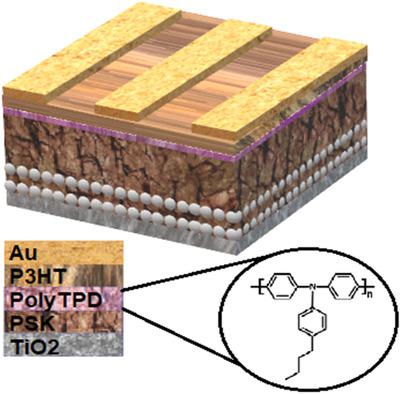当前位置:
X-MOL 学术
›
Energy Technol.
›
论文详情
Our official English website, www.x-mol.net, welcomes your
feedback! (Note: you will need to create a separate account there.)
Poly(N,N′-bis-4-butylphenyl-N,N′-biphenyl)benzidine as Interfacial Passivator for Dopant-Free P3HT Hole Transport Layer-Based Perovskite Solar Cell in Regular Mesoscopic Architecture
Energy Technology ( IF 3.6 ) Pub Date : 2022-02-17 , DOI: 10.1002/ente.202100956 Hassan Kassem 1 , Alireza Salehi 1 , Mojtaba Kahrizi 2 , Hamid Mirzanejad 1 , Amin Hedayati 1 , Behnam Khorasani 1
Energy Technology ( IF 3.6 ) Pub Date : 2022-02-17 , DOI: 10.1002/ente.202100956 Hassan Kassem 1 , Alireza Salehi 1 , Mojtaba Kahrizi 2 , Hamid Mirzanejad 1 , Amin Hedayati 1 , Behnam Khorasani 1
Affiliation

|
The best-recorded performance of perovskite-based solar cells (PSCs) in regular mesoscopic architecture is generally associated with the use of the common 2,2′,7,7′-tetrakis[N,N-di(4-methoxyphenyl)amino]-9,9′-spirobifluorene (Spiro-OMeTAD). However, the need for lithium-based hygroscopic dopants hinders the chemical and environmental stability of the devices. This work presents a passivated stable PSC device based on a dopant-free poly(3-hexylthiophene) (P3HT) hole transport layer. By introducing a poly(N,N′-bis-4-butylphenyl-N,N′-biphenyl)benzidine (polyTPD) interlayer at the perovskite/P3HT interface, the parameters of the low-performance pristine P3HT-based cells are improved. This introduction leads to optimizing the P3HT film morphology, interfacial defects, and charge extraction, along with a significant suppression of interfacial recombination and enhancement of the cell power conversion efficiency (PCE) from 7% to 10.65%. Further, an improvement is observed in open-circuit voltage and the fill factor, increasing from 0.912 to 0.95 V and from 59.2% to 61.1%, respectively. Moreover, the noncapsulated passivated PSC devices exhibit higher operational stability. Examinations show that devices in a dark controlled environment (10–15% humidity) can retain 82% of their initial PCE for 450 h, and 73% of their initial PCE when thermally stressed at 60 °C temperature under ambient conditions (25–35% humidity) for 264 h.
中文翻译:

聚(N,N'-双-4-丁基苯基-N,N'-联苯)联苯胺作为无掺杂P3HT空穴传输层钙钛矿太阳能电池的界面钝化剂
钙钛矿基太阳能电池 (PSC) 在常规介观结构中的最佳记录性能通常与使用常见的 2,2',7,7'-四[ N,N-二(4-甲氧基苯基)氨基]-9,9'-螺二芴 (Spiro-OMeTAD)。然而,对锂基吸湿性掺杂剂的需求阻碍了器件的化学和环境稳定性。这项工作提出了一种基于无掺杂聚 (3-己基噻吩) (P3HT) 空穴传输层的钝化稳定 PSC 器件。通过引入聚( N,N'-双-4-丁基苯基-N,N'-联苯)联苯胺(polyTPD)中间层在钙钛矿/P3HT界面处,改善了低性能原始P3HT基电池的参数。这一介绍导致优化 P3HT 薄膜形态、界面缺陷和电荷提取,同时显着抑制界面复合并将电池功率转换效率 (PCE) 从 7% 提高到 10.65%。此外,开路电压和填充因子也有所改善,分别从 0.912 增加到 0.95 V 和从 59.2% 增加到 61.1%。此外,非封装钝化 PSC 器件表现出更高的操作稳定性。检查表明,在黑暗受控环境(10-15% 湿度)中的设备可以在 450 小时内保持其初始 PCE 的 82%,
更新日期:2022-02-17
中文翻译:

聚(N,N'-双-4-丁基苯基-N,N'-联苯)联苯胺作为无掺杂P3HT空穴传输层钙钛矿太阳能电池的界面钝化剂
钙钛矿基太阳能电池 (PSC) 在常规介观结构中的最佳记录性能通常与使用常见的 2,2',7,7'-四[ N,N-二(4-甲氧基苯基)氨基]-9,9'-螺二芴 (Spiro-OMeTAD)。然而,对锂基吸湿性掺杂剂的需求阻碍了器件的化学和环境稳定性。这项工作提出了一种基于无掺杂聚 (3-己基噻吩) (P3HT) 空穴传输层的钝化稳定 PSC 器件。通过引入聚( N,N'-双-4-丁基苯基-N,N'-联苯)联苯胺(polyTPD)中间层在钙钛矿/P3HT界面处,改善了低性能原始P3HT基电池的参数。这一介绍导致优化 P3HT 薄膜形态、界面缺陷和电荷提取,同时显着抑制界面复合并将电池功率转换效率 (PCE) 从 7% 提高到 10.65%。此外,开路电压和填充因子也有所改善,分别从 0.912 增加到 0.95 V 和从 59.2% 增加到 61.1%。此外,非封装钝化 PSC 器件表现出更高的操作稳定性。检查表明,在黑暗受控环境(10-15% 湿度)中的设备可以在 450 小时内保持其初始 PCE 的 82%,






























 京公网安备 11010802027423号
京公网安备 11010802027423号